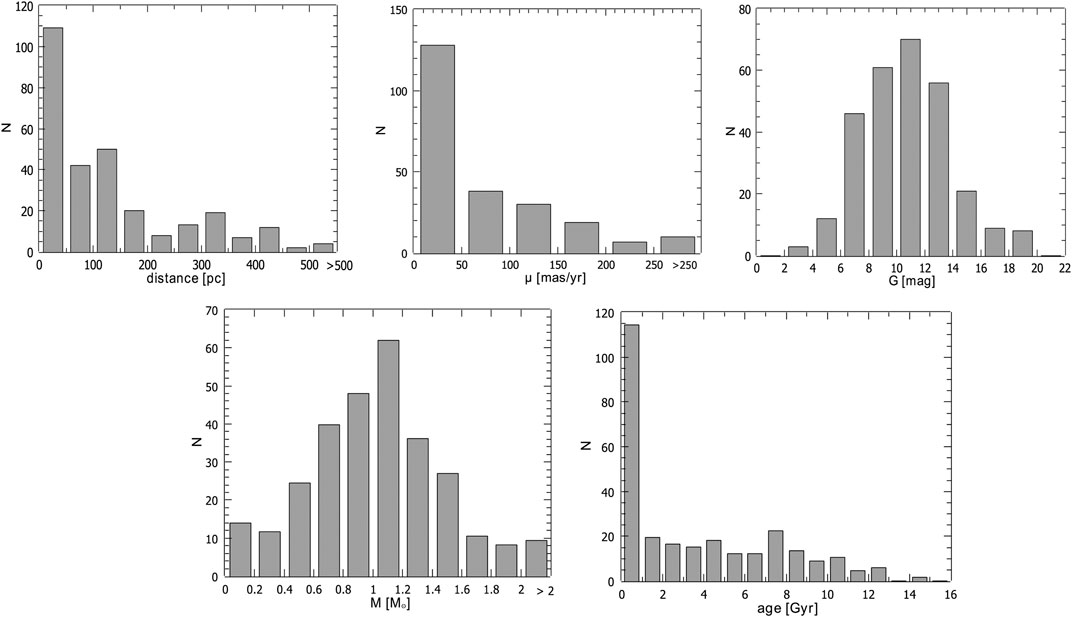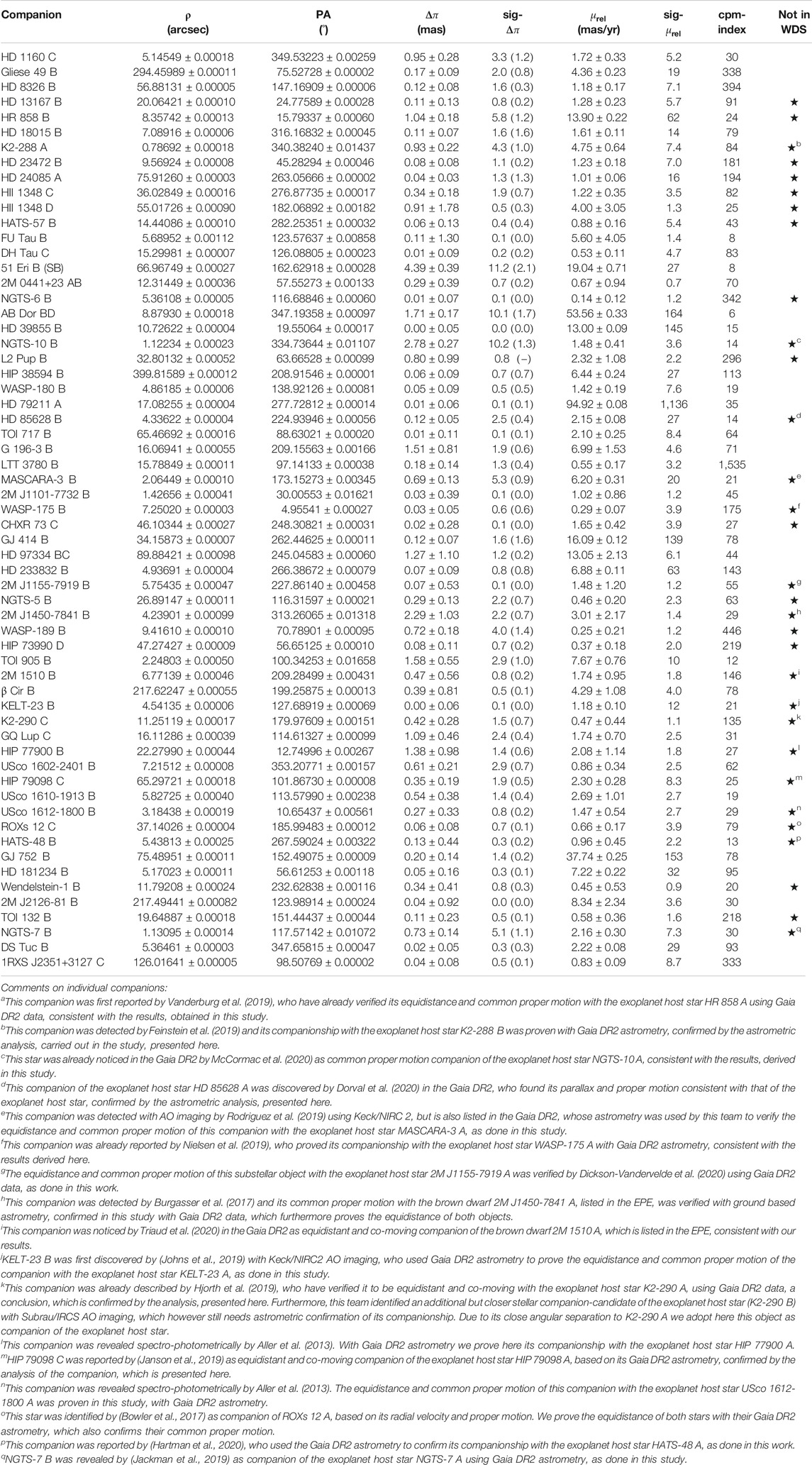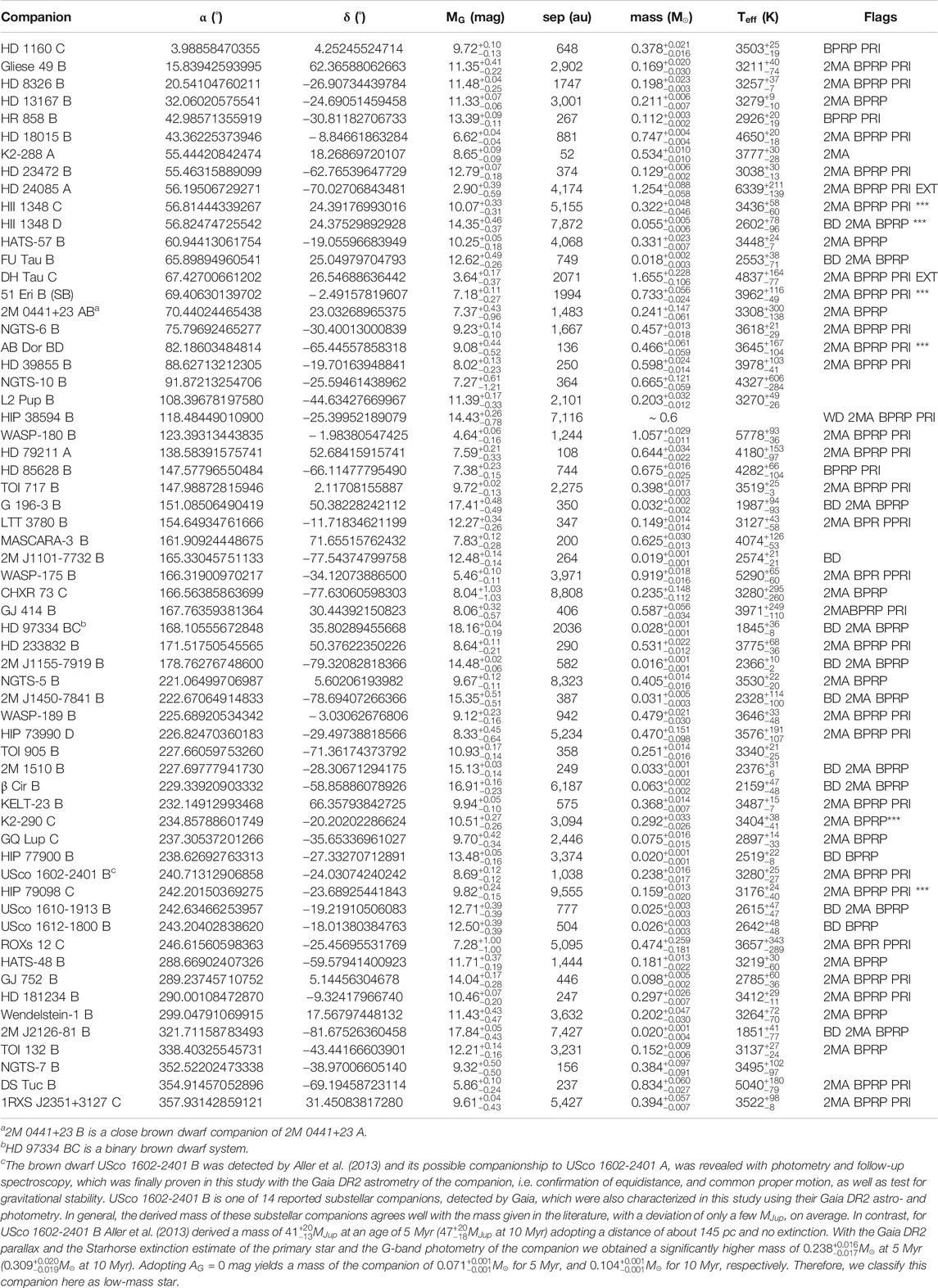- Astrophysikalisches Institut und Universitäts-Sternwarte Jena, Jena, Germany
We present the latest results of an ongoing multiplicity survey of exoplanet hosts, which was initiated at the Astrophysical Institute and University Observatory Jena, using data from the second data release of the ESA-Gaia mission. In this study the multiplicity of 289 targets was investigated, all located within a distance of about 500 pc from the Sun. In total, 41 binary, and five hierarchical triple star systems with exoplanets were detected in the course of this project, yielding a multiplicity rate of the exoplanet hosts of about 16%. A total of 61 companions (47 stars, a white dwarf, and 13 brown dwarfs) were detected around the targets, whose equidistance and common proper motion with the exoplanet hosts were proven with their precise Gaia DR2 astrometry, which also agrees with the gravitational stability of most of these systems. The detected companions exhibit masses from about 0.016 up to 1.66 M⊙ and projected separations in the range between about 52 and 9,555 au.
1 Introduction
Since the detection of the first planet orbiting a star other than the Sun, several thousands of these exoplanets have been discovered by various detection techniques. While the majority of stars are members of multiple star systems (Duchêne and Kraus, 2013), most of the exoplanet host stars are single stars. Nevertheless several multiple star systems hosting exoplanets, could already be revealed by previous multiplicity studies using seeing limited or high contrast AO imaging observations (see e.g. Mugrauer et al., 2014; Mugrauer and Ginski, 2015). In order to explore the effects of the presence of stellar companions on the formation process and orbital evolution of exoplanets, a survey was initiated at the Astrophysical Institute and University Observatory Jena (described in detail by Mugrauer, 2019) to identify and characterize companions of exoplanet host stars, detected in the second data release of the European Space Agency (ESA) Gaia mission (Gaia DR2 from hereon, Gaia Collaboration et al., 2018). Furthermore, in Mugrauer and Michel (2020) a comparable investigation was carried out among potential exoplanet host stars, identified by the TESS mission (Ricker et al., 2015). The study, whose results are presented here, is the third work in the context with Mugrauer (2019). The following section gives a detailed description of this study, and the detected companions and their derived properties are presented in the third section of this paper.
2 Gaia DR2 Search for (sub)stellar Companions of Exoplanet Hosts
The Gaia DR2 is based on data taken by the Gaia spacecraft in the first 22 months of its mission and contains 1.7 billion detected sources up to a limiting magnitude of G = 21 mag. For 1.3 billion sources a five parameter astrometric solution could be derived, i.e. beside their equatorial coordinates (α, δ), also the parallax π and proper motion (
Using Gaia DR2 data Mugrauer (2019) already explored the multiplicity of all exoplanet host stars, whose exoplanets were detected either by photometric transit observations, radial-velocity (RV), or astrometric measurements, and were listed in the Extrasolar Planets Encyclopedia1 (EPE from hereon, Schneider et al., 2011) by mid of October 2018. The study, presented in this paper, complements this survey by investigating the multiplicity of the exoplanet hosts (stars but also brown dwarfs), whose planets were indirectly detected either via RV measurements or transit observations in the range of time between mid of October 2018 until end of September 2020, as well as all exoplanet hosts, known so far, with planets, which were directly detected by imaging observations. At the end of September 2020 the EPE lists about 4,350 exoplanets, and about 400 of them were detected around the hosts studied in this work.
(Sub)stellar Companions are expected to be located at the same distance to the Sun as the exoplanet hosts and form common proper motion pairs with them, in particular wide companions with projected separations of hundreds and thousands of au, i.e. the typical targets of this study. Hence, in order to clearly detect such companions and to prove the equidistance of these objects and the exoplanet hosts, in this study we have taken into account only Gaia DR2 sources with an accurate five parameter astrometric solution, i.e. which exhibit precise measurements of their parallax (

TABLE 1. The properties of all targets of this study. The corresponding histograms are shown in Figure 1.
The companion search radius, applied in this project around the selected targets, is limited to a maximal projected separation of 10,000 au, which guarantees that the majority of wide companions of the exoplanet hosts are detectable in this study, as described by Mugrauer (2019). This upper separation limit results in an angular search radius around the targets of
Following the companion identification procedure (
The absolute G-band magnitude of all companions was derived from their apparent G-band photometry, the parallax of the associated exoplanet hosts, as well as their Apsis-Priam G-band extinction estimate, all listed in the Gaia DR2. If there was no extinction estimate given for a companion, the extinction estimate of the exoplanet host was used instead or if not available, its extinction estimate, listed in the StarHorse catalog (Anders et al., 2019). In the case that no G-band extinction is available at all it was derived from V-band extinction measurements of the exoplanet hosts, listed either in the VizieR data base2 (Ochsenbein et al., 2000) or in the literature, adopting
The masses and effective temperatures of all detected companions were determined from their derived absolute G-band magnitudes using the evolutionary models of (sub)stellar objects from Baraffe et al. (2015), as well as the ages of the exoplanet hosts, as listed in the EPE. Thereby, we adopt the same age for the planet hosts and their companions. We determined the masses and effective temperatures of the companions via interpolation of the model grid with the age closest to that of the exoplanet hosts. For verification of the obtained results the properties of the companions derived from their G-band magnitudes were compared with those, determined from the near-infrared photometry, taken from the 2MASS Point Source catalog (Skrutskie et al., 2006), if available. For the near-infrared extinction we have used the relations:
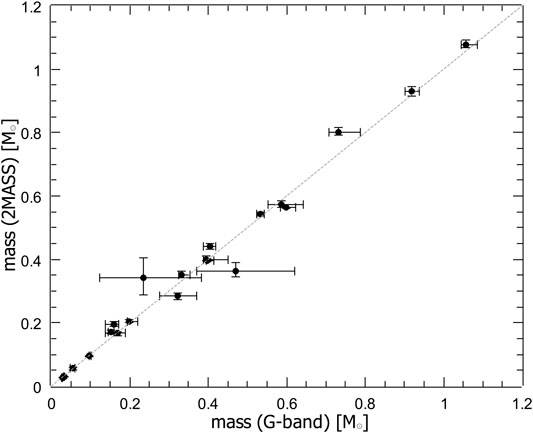
FIGURE 2. Comparison of the mass of the detected companions, derived from their G-band and infrared 2MASS photometry.
Eventually for all companions, which were detected in this study, we have estimated their escape velocity
3 Detected Companions of Exoplanet Hosts
The Gaia astro- and photometry of all exoplanet hosts and their companions, detected in this study, are listed in Table 2. The derived properties of the companions are summarized in Table 3–5. In all tables the exoplanet host systems or the companions are sorted by their right ascension. The used identifier of the targets corresponds either to the one used in the EPE or is a slightly abbreviated version of it. In contrast to the planet definition used by the EPE, in which substellar objects below 60
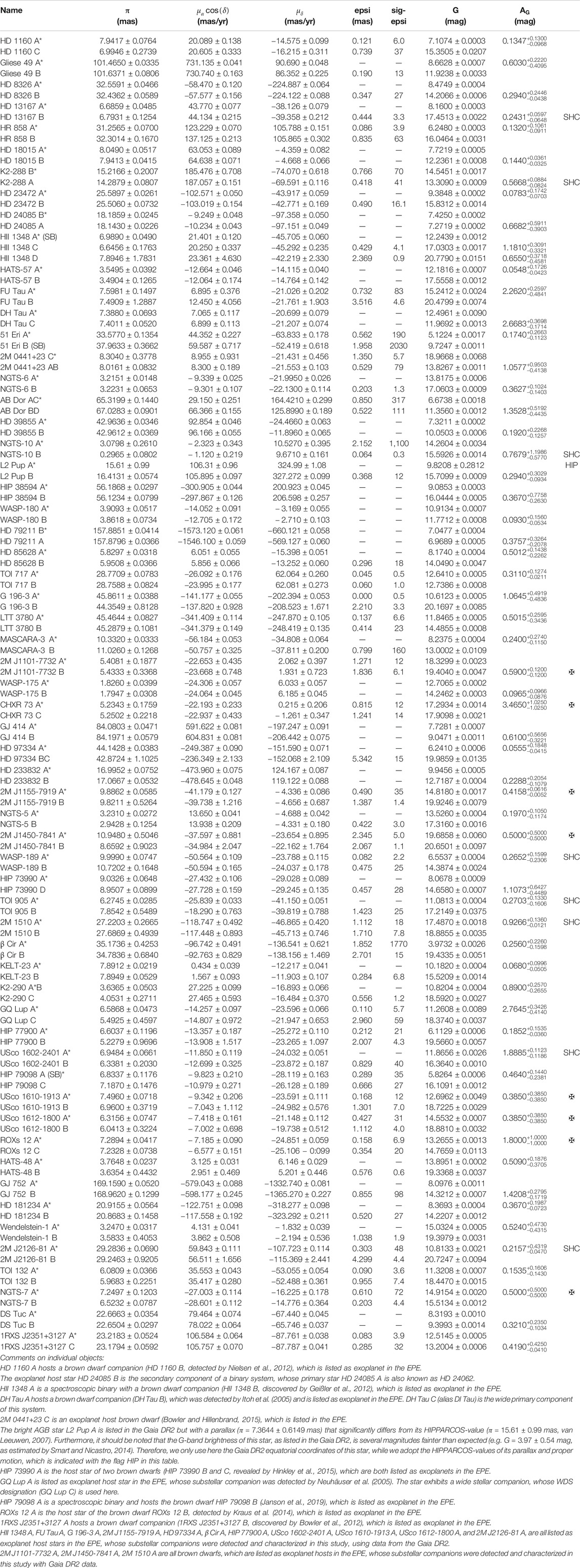
TABLE 2. Gaia astro- and photometry of all exoplanet hosts and their companions, detected in this study.

TABLE 5. List of all detected companions, whose differential proper motion
In Table 2 for each exoplanet host and its detected co-moving companion(s) their Gaia DR2 parallax π, proper motion in right ascension and declination (
Table 3 lists for each detected companion its angular separation (ρ) and position angle (
In Table 4 beside the equatorial coordinates (α, δ both for epoch 2015.5) of all detected companions, their derived absolute G-band magnitude
PRI: An Apsis-Priam temperature estimate is available for the detected companion, which could be compared with the effective temperature of the companion, derived from its absolute G-band photometry using the Baraffe et al. (2015) models.
2MA: The companion is listed in the 2MASS Point Source catalog.
BPRP: The
EXT: Because of its brightness the companion exceeds the magnitude range of the Baraffe et al. (2015) evolutionary models. Therefore, the properties of the companion were estimated via extrapolation from the two brightest sources of the used model isochrone.
WD: The detected companion is a white dwarf.
BD: The detected companion is a brown dwarf.
Finally, in Table 5 we summarize all those detected companions, whose differential proper motion
Among all 289 targets, whose multiplicity was investigated in the study, whose results are presented in this paper, 41 binary and five hierarchical triple star systems with exoplanets were identified. This yields a multiplicity rate of the targets of 16 ± 2%, very well consistent with the multiplicity rate of exoplanet host stars of 15 ± 1%, reported before by Mugrauer (2019). This is as expected, as the sensitivities of the two surveys should agree well with each other, as the brightness and mass of their targets match, and the distance of the targets from this survey is on average about 40% smaller than that of the targets from Mugrauer (2019), resulting in a reduction in the distance modulus of only about 1 mag. In total, 61 companions (48 stars and 13 brown dwarfs) could be detected in the Gaia DR2 around the targets. The detected substellar companions are all listed as exoplanets in the EPE. The cumulative distribution functions of the derived properties (projected separation, mass and effective temperature) of theses companions, are illustrated in Figures 3–5. The separation-mass diagram of the companions is shown in Figure 6. As described above, the accurate Gaia DR2 astrometry proves the equidistance and common proper motion of all detected companions with the associated exoplanet hosts, and for the majority of these companions their differential proper motion to the exoplanet hosts is slower than their estimated escape velocity, facts that are expected for gravitationally bound systems. In contrast, the differential proper motion of the companions, which are listed in Table 5, exceeds their estimated escape velocity, possibly indicating a higher degree of multiplicity4. Indeed, one of these companions (51 Eri BC) is already known to be a close binary itself. The remaining two companions and their primaries are promising targets for follow-up observations to check their multiplicity status e.g. with high contrast AO imaging observations.
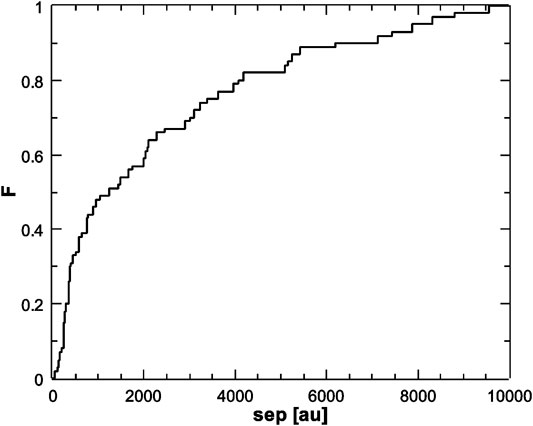
FIGURE 3. The cumulative distribution function of the projected separation (sep) of all detected companions to the associated exoplanet hosts.
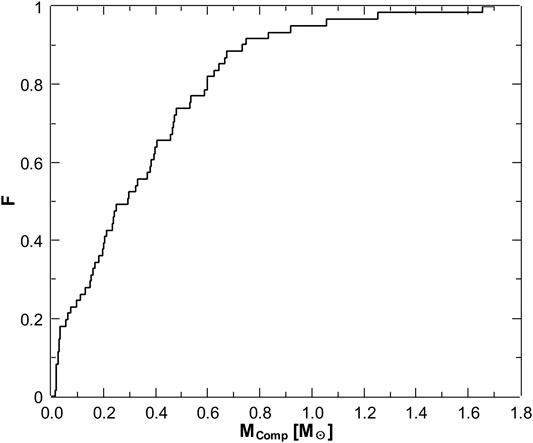
FIGURE 4. The cumulative distribution function of the mass of all companions, detected in this study.
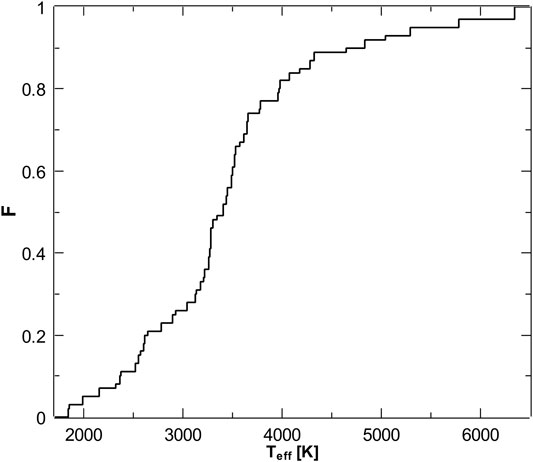
FIGURE 5. The cumulative distribution function of the effective temperature of all detected companions.
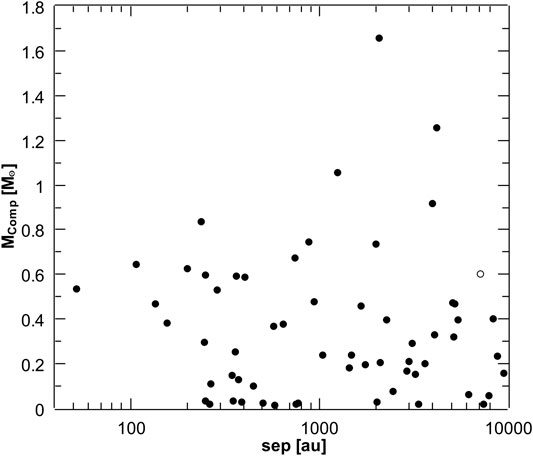
FIGURE 6. The mass of all companions, detected in this study, plotted over their projected separation (sep) to the associated exoplanet hosts. The white dwarf companion HIP 38594 B, is illustrated as open circle.
All detected companions exhibit projected separations to the associated exoplanet hosts in the range between 52 and 9,555 au (average separation of about 2,310 au). The highest companion frequency is found at projected separations between about 240 and 400 au and half of all companions are located at projected separations below about 1,240 au. The closest detected companion is K2-288 A, which is separated from the exoplanet host star K2-288 B by 52 au, and it is the only companion identified in this study within a projected separation of 100 au. The masses of the companions range between 0.016 and 1.66
In general the effective temperature of the detected companions, determined with their derived absolute G-band magnitude, using the evolutionary Baraffe et al. (2015) models, agree well with their Gaia DR2 Apsis-Priam temperature estimate (if available) with a characteristic deviation of about ±350 K, consistent with the typical uncertainty of the different temperature estimates, which is in the order of about 330 K. Only in the case of HIP 38594 B the temperature estimate, based on the absolute G-band photometry of the companion significantly deviates by more than 2300 K from its Apsis-Priam temperature estimate, which is also about 900 K higher than the one of the associated exoplanet host star HIP 38594 A. Furthermore, the companion appears bluer (
In Figure 7 the G-band magnitude difference of all detected companions to the associated exoplanet hosts is plotted vs. their angular separation. For comparison we show as dashed line in this figure the estimate of the Gaia detection limit, reported by Mugrauer (2019) which was further constrained by Mugrauer and Michel (2020). Companions of exoplanet hosts brighter than 12.8 mag are plotted as open circles those of hosts, which are fainter than that magnitude limit, as filled black circles, respectively. A magnitude difference of about 5 mag is reached at an angular separation of about two arcsec, consistent with the estimate of the Gaia detection limit, determined by Mugrauer (2019). Only two companions significantly exceed the limit estimate, namely K2-288 A at an angular separation of about 0.8 arcsec with
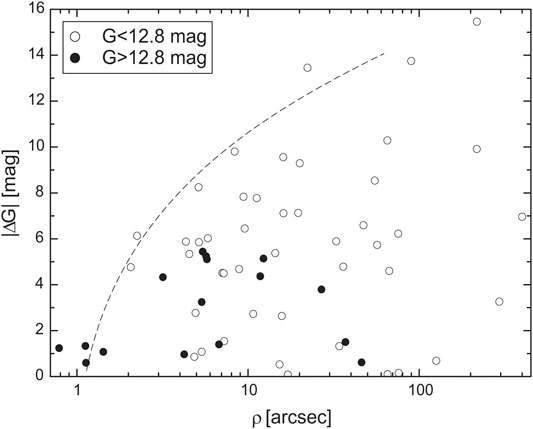
FIGURE 7. The G-band magnitude difference of all detected companions, plotted over their angular separation to the associated exoplanet hosts.
4 Summary and Outlook
The study, presented here, is a continuation of a survey, which was initiated at the Astrophysical Institute and University Observatory Jena, to investigate the multiplicity status of exoplanet hosts and to characterize the properties of their detected (sub)stellar companions, using accurate Gaia astro- and photometry. In this paper the multiplicity of 289 exoplanet hosts was explored and (sub)stellar companions were detected around 60 targets. The companionship of these objects with the exoplanet hosts could be proven with their accurate Gaia DR2 astrometry (equidistance, common proper motion, and differential proper motion smaller than the expected escape velocity). The mass and effective temperature of all companions were determined with their derived absolute G-band photometry and the Baraffe et al. (2015) evolutionary models of (sub)stellar objects. In total, 61 companions (beside 48 stellar companions, among them the white dwarf HIP 38594 B, also 13 brown dwarfs) were detected in this project, and 14 of these objects are neither listed in the WDS as companion (-candidate)s of the targets nor were described in the literature before. A total of 41 binary and five triple star systems with exoplanets, were identified in this study, yielding a multiplicity rate of the targets of about 16%, which is very well consistent with the multiplicity rate of exoplanet host stars, reported by Mugrauer (2019). Following the standard procedure of our survey, all detected companions and their derived properties will be made available online in the VizieR database. The survey, whose latest results are presented here, is an ongoing project as more and more exoplanet hosts are detected by different planet detection methods, whose multiplicity status needs to be investigated. Furthermore, there are sources, listed in the Gaia DR2, within the applied search radius around the targets, which still lack a five parameter astrometric solution. Hence, further companions of the exoplanet hosts, investigated here, should exist, whose companionship can be proven with accurate astrometric measurements, provided by future data releases of the ESA-Gaia mission, e.g. the Gaia EDR3, planed to be published end of 2020.
The results of this survey, which is mainly sensitive for wide companions of exoplanet hosts, combined with those of our currently ongoing large high contrast imaging surveys (sensitive for close companions), carried out with SPHERE/VLT and AstraLux/CAHA (first results are already published e.g. by Ginski et al., 2020) will yield a complete characterization of the multiplicity status of the observed targets. This will eventually allow to draw conclutions on the impact of the stellar multiplicity on the formation process of planets and the evolution of their orbits.
Data Availability Statement
Publicly available datasets were analyzed in this study. This data can be found here: https://vizier.u-strasbg.fr/viz-bin/VizieR-3?-source=I/345/gaia2&-out.max=50&-out.form=HTML%20Table&-out.add=_r&-out.add=_RAJ,_DEJ&-sort=_r&-oc.form=sexa.
Author Contributions
K-UM and MM have worked together on the data analysis and its publication.
Conflict of Interest
The authors declare that the research was conducted in the absence of any commercial or financial relationships that could be construed as a potential conflict of interest.
Acknowledgments
We thank the two anonymous referees for their helpful and constructive comments on the manuscript. We made use of data from: (1) the Simbad and VizieR databases, both operated at CDS in Strasbourg, France. (2) the European Space Agency (ESA) mission Gaia (https://www.cosmos.esa.int/gaia), processed by the Gaia Data Processing and Analysis Consortium (DPAC, https://www.cosmos.esa.int/web/gaia/dpac/consortium). Funding for the DPAC has been provided by national institutions, in particular the institutions participating in the Gaia Multilateral Agreement. (3) the Two Micron All Sky Survey, which is a joint project of the University of Massachusetts and the Infrared Processing and Analysis Center/California Institute of Technology, funded by the National Aeronautics and Space Administration and the National Science Foundation.
Footnotes
1Online available at: http://exoplanet.eu/
2Online available at: https://vizier.u-strasbg.fr/
3The astrometric excess noise is conservatively considered here as additional parallax uncertainty of the source.
4Additional close companions either of the exoplanet hosts or of the companions force these objects on close orbits with high orbital velocities around a common barycenter that could induce the observed high differential velocities.
5Online available at: http://www.pas.rochester.edu/∼emamajek/EEM_dwarf_UBVIJHK_colors_Teff.txt
References
Aller, K. M., Kraus, A. L., Liu, M. C., Burgett, W. S., Chambers, K. C., Hodapp, K. W., et al. (2013). A pan-STARRS + UKIDSS search for young, wide planetary-mass companions in upper scorpius. ApJ 773, 63. doi:10.1088/0004-637X/773/1/63
Anders, F., Khalatyan, A., Chiappini, C., Queiroz, A. B., Santiago, B. X., Jordi, C., et al. (2019). Photo-astrometric distances, extinctions, and astrophysical parameters for Gaia DR2 stars brighter than G = 18. A&A 628, A94. doi:10.1051/0004-6361/201935765
Bailer-Jones, C. A. L., Andrae, R., Arcay, B., Astraatmadja, T., Bellas-Velidis, I., Berihuete, A., et al. (2013). TheGaiaastrophysical parameters inference system (Apsis). A&A 559, A74. doi:10.1051/0004-6361/201322344
Baraffe, I., Homeier, D., Allard, F., and Chabrier, G. (2015). New evolutionary models for pre-main sequence and main sequence low-mass stars down to the hydrogen-burning limit. A&A 577, A42. doi:10.1051/0004-6361/201425481
Basri, G. (2000). Observations of Brown dwarfs. Annu. Rev. Astron. Astrophys. 38, 485–519. doi:10.1146/annurev.astro.38.1.485
Bowler, B. P., and Hillenbrand, L. A. (2015). Near-infrared spectroscopy of 2M0441+2301 AabBab: a quadruple system spanning the stellar to planetary mass regimes. ApJ 811, L30. doi:10.1088/2041-8205/811/2/L30
Bowler, B. P., Kraus, A. L., Bryan, M. L., Knutson, H. A., Brogi, M., Rizzuto, A. C., et al. (2017). The young substellar companion ROXs 12 B: near-infrared spectrum, system Architecture, and spin-orbit misalignment. AJ 154, 165. doi:10.3847/1538-3881/aa88bd
Bowler, B. P., Liu, M. C., Shkolnik, E. L., Dupuy, T. J., Cieza, L. A., Kraus, A. L., et al. (2012). Planets around low-mass stars (PALMS). I. A substellar companion to the young M dwarf 1RXS J235133.3+312720. ApJ 753, 142. doi:10.1088/0004-637X/753/2/142
Burgasser, A. J., Looper, D. L., and Kirkpatrick, J. D. (2017). A candidate wide Brown dwarf binary in the argus association: 2MASS J14504216-7841413 and 2MASS J14504113-7841383. Res. Notes AAS 1, 42. doi:10.3847/2515-5172/aa9ff0
Dickson-Vandervelde, D. A., Wilson, E. C., and Kastner, J. H. (2020). Identification of the youngest known substellar object within ∼100 pc. Res. Notes AAS 4, 25. doi:10.3847/2515-5172/ab7344
Dorval, P., Talens, G. J. J., Otten, G. P. P. L., Brahm, R., Jordán, A., Torres, P., et al. (2020). MASCARA-4 b/bRing-1 b: A retrograde hot Jupiter around a bright A-type star. A&A 635, A60. doi:10.1051/0004-6361/201935611
Duchêne, G., and Kraus, A. (2013). Stellar multiplicity. Annu. Rev. Astron. Astrophys. 51, 269–310. doi:10.1146/annurev-astro-081710-102602
Feinstein, A. D., Schlieder, J. E., Livingston, J. H., Ciardi, D. R., Howard, A. W., Arnold, L., et al. (2019). K2-288Bb: a small temperate planet in a low-mass binary system discovered by citizen scientists. AJ 157, 40. doi:10.3847/1538-3881/aafa70
Gaia Collaboration, , Brown, A. G. A., Vallenari, A., Prusti, T., de Bruijne, J. H. J., Babusiaux, C., et al. (2018). Gaia Data Release 2. Summary of the contents and survey properties. A&A 616, A1. doi:10.1051/0004-6361/201833051
Geißler, K., Metchev, S. A., Pham, A., Larkin, J. E., McElwain, M., and Hillenbrand, L. A. (2012). A substellar common proper-motion companion to the pleiad H II 1348. ApJ 746, 44. doi:10.1088/0004-637X/746/1/44
Ginski, C., Mugrauer, M., Adam, C., Vogt, N., and van Holstein, R. (2020). How many suns are in the sky? A sphere multiplicity survey of exoplanet host stars I – Four new close stellar companions including a white dwarf. Available at: http://arxiv.org/abs/2009.10363.
Hartman, J. D., Jordán, A., Bayliss, D., Bakos, G. Á., Bento, J., Bhatti, W., et al. (2020). HATS-47b, HATS-48Ab, HATS-49b, and HATS-72b: four warm giant planets transiting K dwarfs. AJ 159, 173. doi:10.3847/1538-3881/ab7821
Hinkley, S., Kraus, A. L., Ireland, M. J., Cheetham, A., Carpenter, J. M., Tuthill, P., et al. (2015). Discovery of seven companions to intermediate-mass stars with extreme mass ratios in the scorpius-centaurus association. ApJ 806, L9. doi:10.1088/2041-8205/806/1/L9
Hjorth, M., Justesen, A. B., Hirano, T., Albrecht, S., Gandolfi, D., Dai, F., et al. (2019). K2-290: a warm Jupiter and a mini-Neptune in a triple-star system. MNRAS 484, 3522–3536. doi:10.1093/mnras/stz139
Itoh, Y., Hayashi, M., Tamura, M., Tsuji, T., Oasa, Y., Fukagawa, M., et al. (2005). A young Brown dwarf companion to DH tauri. ApJ 620, 984–993. doi:10.1086/427086
Jackman, J. A. G., Wheatley, P. J., Bayliss, D., Gill, S., Hodgkin, S. T., Burleigh, M. R., et al. (2019). NGTS-7Ab: an ultrashort-period brown dwarf transiting a tidally locked and active M dwarf. MNRAS 489, 5146–5164. doi:10.1093/mnras/stz2496
Janson, M., Asensio-Torres, R., André, D., Bonnefoy, M., Delorme, P., Reffert, S., et al. (2019). The B-Star Exoplanet Abundance Study: a co-moving 16-25 MJup companion to the young binary system HIP 79098. A&A 626, A99. doi:10.1051/0004-6361/201935687
Johns, D., Reed, P. A., Rodriguez, J. E., Pepper, J., Stassun, K. G., Penev, K., et al. (2019). KELT-23Ab: a hot Jupiter transiting a near-solar twin close to the TESS and JWST continuous viewing zones. AJ 158, 78. doi:10.3847/1538-3881/ab24c7
Kraus, A. L., Ireland, M. J., Cieza, L. A., Hinkley, S., Dupuy, T. J., Bowler, B. P., et al. (2014). Three wide planetary-mass companions to FW Tau, ROXs 12, and ROXs 42B. ApJ 781, 20. doi:10.1088/0004-637X/781/1/20
Mason, B. D., Wycoff, G. L., Hartkopf, W. I., Douglass, G. G., and Worley, C. E. (2001). The 2001 US naval observatory Double star CD-ROM. I. The Washington Double star catalog. AJ 122, 3466. doi:10.1086/323920
McCormac, J., Gillen, E., Jackman, J. A. G., Brown, D. J. A., Bayliss, D., Wheatley, P. J., et al. (2020). NGTS-10b: the shortest period hot Jupiter yet discovered. MNRAS 493, 126–140. doi:10.1093/mnras/staa115
Mugrauer, M., and Ginski, C. (2015). High-contrast imaging search for stellar and substellar companions of exoplanet host stars. MNRAS 450, 3127–3136. doi:10.1093/mnras/stv771
Mugrauer, M., Ginski, C., and Seeliger, M. (2014). New wide stellar companions of exoplanet host stars. MNRAS 439, 1063–1070. doi:10.1093/mnras/stu044
Mugrauer, M., and Michel, K. U. (2020). Gaia search for stellar companions of TESS objects of interest. Available at: http://arxiv.org/abs/2009.12234.
Mugrauer, M. (2019). Search for stellar companions of exoplanet host stars by exploring the second ESA-Gaia data release. MNRAS 490, 5088–5102. doi:10.1093/mnras/stz2673
Neuhäuser, R., Guenther, E. W., Wuchterl, G., Mugrauer, M., Bedalov, A., and Hauschildt, P. H. (2005). Evidence for a co-moving sub-stellar companion of GQ Lup. A&A 435, L13–L16. doi:10.1051/0004-6361:200500104
Nielsen, E. L., Liu, M. C., Wahhaj, Z., Biller, B. A., Hayward, T. L., Boss, A., et al. (2012). The gemini NICI planet-finding campaign: discovery of a multiple system orbiting the young A star HD 1160. ApJ 750, 53. doi:10.1088/0004-637X/750/1/53
Nielsen, L. D., Bouchy, F., Turner, O. D., Anderson, D. R., Barkaoui, K., Benkhaldoun, Z., et al. (2019). WASP-169, WASP-171, WASP-175, and WASP-182: three hot Jupiters and one bloated sub-Saturn mass planet discovered by WASP-South. MNRAS 489, 2478–2487. doi:10.1093/mnras/stz2351
Ochsenbein, F., Bauer, P., and Marcout, J. (2000). The VizieR database of astronomical catalogues. Astron. Astrophys. Suppl. Ser. 143, 23–32. doi:10.1051/aas:2000169
Pecaut, M. J., and Mamajek, E. E. (2013). Intrinsic colors, temperatures, and bolometric corrections of pre-main-sequence stars. ApJS 208, 9. doi:10.1088/0067-0049/208/1/9
Ricker, G. R., Winn, J. N., Vanderspek, R., Latham, D. W., Bakos, G. Á., Bean, J. L., et al. (2015). Transiting exoplanet survey satellite (TESS). JATIS 1, 014003. doi:10.1117/1.JATIS.1.1.014003
Rodriguez, J. E., Eastman, J. D., Zhou, G., Quinn, S. N., Beatty, T. G., Penev, K., et al. (2019). KELT-24b: a 5M J planet on a 5.6 day well-aligned orbit around the young V = 8.3 F-star HD 93148. AJ 158, 197. doi:10.3847/1538-3881/ab4136
Schneider, J., Dedieu, C., Le Sidaner, P., Savalle, R., and Zolotukhin, I. (2011). Defining and cataloging exoplanets: the exoplanet.eu database. A&A 532, A79. doi:10.1051/0004-6361/201116713
Skrutskie, M. F., Cutri, R. M., Stiening, R., Weinberg, M. D., Schneider, S., Carpenter, J. M., et al. (2006). The two Micron all sky survey (2MASS). Astron. J. 131, 1163–1183. doi:10.1086/498708
Smart, R. L., and Nicastro, L. (2014). The initialGaiasource list. A&A 570, A87. doi:10.1051/0004-6361/201424241
Subasavage, J. P., Henry, T. J., Bergeron, P., Dufour, P., and Hambly, N. C. (2008). The solar neighborhood. Xx. Discovery and characterization of 21 new nearby white dwarf systems. Astronomical J. 136, 899–908. doi:10.1088/0004-6256/136/3/899
Triaud, A. H. M. J., Burgasser, A. J., Burdanov, A., Kunovac Hodžić, V., Alonso, R., Bardalez Gagliuffi, D., et al. (2020). An eclipsing substellar binary in a young triple system discovered by speculoos. Nat. Astron. 4, 650–657. doi:10.1038/s41550-020-1018-2
van Leeuwen, F. (2007). Validation of the new Hipparcos reduction. A&A 474, 653–664. doi:10.1051/0004-6361:20078357
Keywords: Multiple stars, white dwarfs, brown dwarfs, exoplanets, ESA-Gaia DR2
Citation: Michel K-U and Mugrauer M (2021) Search for (sub)stellar Companions of Exoplanet Hosts by Exploring the Second ESA-Gaia Data Release. Front. Astron. Space Sci. 8:624907. doi: 10.3389/fspas.2021.624907
Received: 01 November 2020; Accepted: 25 January 2021;
Published: 29 March 2021.
Edited by:
Rachel Matson, United States Naval Observatory (USNO), United StatesReviewed by:
Claudio Melo, European Southern Observatory, ChileRobert De Rosa, European Southern Observatory, Chile
Copyright © 2021 Michel and Mugrauer. This is an open-access article distributed under the terms of the Creative Commons Attribution License (CC BY). The use, distribution or reproduction in other forums is permitted, provided the original author(s) and the copyright owner(s) are credited and that the original publication in this journal is cited, in accordance with accepted academic practice. No use, distribution or reproduction is permitted which does not comply with these terms.
*Correspondence: K.-U. Michel, a2FpLXV3ZS5taWNoZWxAdW5pLWplbmEuZGU=
 K.-U. Michel
K.-U. Michel M. Mugrauer
M. Mugrauer